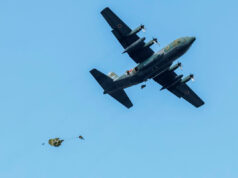BAE Systems, in collaboration with UAVTEK, has developed a nano “Bug” drone, and delivered the first 30 units to the British Army, which has put it through its paces as part of a trial.
The Bug is a nano-Unmanned Aerial Vehicle (UAV) weighing 196g – similar to the weight of a smartphone – with 40 minute battery life and a 2km range. It boasts a stealthy low visual profile and the ability to fly even in strong winds of more than 50mph.
BAE say it was the only nano-UAV able to cope with the uncompromising weather during a recent Army Warfighting Experiment (AWE) event hosted by the Ministry of Defence’s Future Capability Group.

“We delivered the Bug in partnership with UAVTEK, an SME that designs and builds UAVs from its workshop in the Cotswolds. Our experience in developing large volumes of secure hardware means we were able to help the team turn the excellent design into a real product which our Armed Forces can use. This kind of collaboration is happening right across BAE Systems and is a great way to quickly get the best thinking from small companies into the hands of military users.” said James Gerard, Principal Technologist at BAE Systems Applied Intelligence business, in a news release received by the UK Defence Journal.
James added: “In even the toughest weather, the Bug can deliver vital tactical intelligence on what’s around the corner or over the next hill, working autonomously to give troops a visual update. Combined with our other information advantage products, this video feed could be shared multi-domain, enabling commanders on land, sea and air to increase their situational awareness and inform their decisions.”
BAE said in a statement:
“Innovations at the annual AWE event are designed to explore emerging technologies and identify specific capabilities, this year focusing on Agile Command, Control and Communication (C3) space suitable for rapid exploitation. Emphasis is placed on innovations which push the boundaries of technology and military capability, testing a range of prototype systems by putting them in the hands of the user whilst giving invaluable military feedback to suppliers.”
Jenna Copley, Director at UAVTEK said:
“BAE Systems has been extremely supportive of us as an SME and the team has shared procedural knowledge to improve our engineering processes and practices. BAE Systems has effectively offered us a mentoring partnership and supported us in a variety of activities, whilst still enabling us to remain an agile SME and keep our core offerings and DNA.”
The teams are now working on the next developments on the nano-UAV, exploring sensing equipment and capabilities which could be added, as well as how the Bug could be integrated with other military equipment.














Great work from a UK company UAVTEK beating flir systems & providing a great capability to UK forces hopefully more orders of their range will be procured such as tethered UAV. AWE actually producing a procurement outcome
Hear hear. We need more of this. We have the amazing talent and the technology, we can and should start beating US defence companies for worldwide contracts.
We do in some regards, BAE systems is the 3rd biggest defence contractor.
Of course Talent and Tech have never been an issue for the UK, as you well know, George. It’s primarily the Get Rich Quick ‘Investment’ (so called) Merchants who hold back the UK by continually selling us out. No imagination or guts, just greed.
Happy New Year, though!
Regards
Any chance we can see how much they are ? ….. I have a feeling they ain’t going to be cheap …… unless we got them as a job lot from China.
Everything comes down to cost I guess but these do look pretty handy although running around like that wasn’t really my job. Be interesting to see what some of the pongo-ey types think of them.
About £4500 each……
or similar spec for under £500 at amazon.
not entirely clear what this does that consumer models don’t.
For the life in me I simply can’t understand the British MOD and its pound foolish and penny shy mindset. In 2011 the UK purchased and used the Black Hornet Nano , then in 2016 the Uk decided to get rid of them as mentioned by this blog in 2017:
British armed forces cut 37% of unmanned aircraft systems in one year
https://ukdefencejournal.org.uk/british-armed-forces-cut-37-unmanned-aircraft-systems-one-year/
Then last year they decided to reintroduce it into British service. This constant chopping and changing by the so called experts is a bigger threat to the UK military than anything else.
It comes down to requirements, and if we actually need them, things change, and we respond accordingly. This is a British designed Nano bug, great capability, designed and built in the UK.
This tech is going to revolutionise soldiering. No more recce patrols, standing patrols and listening posts. A Platoon commander will be able to deploy drones to win the information battlespace. The simple ability to see around corners, look in rooms when house clearing or over a hedge will save lives. You can even see a stage when individual soldiers will be able to receive real time intelligence that is networked through the section via helmet mounted miniature display units.
What about the enemies nano bug invading our battle space whilst they sit back and drink from their samovar.
Rob, I think you have it wrong, it won’t (and shouldn’t) replace patrolling in any way -it should enhance tactical actions by extending their reach, field of view and ISTAR capabilities. It’s an ISTAR platform; patrolling dominates ground, gains information and keeps the enemy on the back foot in all tactical functions.
Rob, I think you have it wrong, it won’t (and shouldn’t) replace patrolling in any way -it should enhance tactical actions by extending their reach, field of view and ISTAR capabilities. In essence, this aids the FIND, and may aid FIX and STRIKE if and it is a big if, you can observe and adjust STRIKE using it. It may also aid EXPLOIT if you can use it to assess where you can EXPLOIT.
However, I never led a Platoon attack on live operations that lasted only 40 minutes. In fact the longest action I was in in Afghanistan lasted 18 hours. So as a Pl or Coy Comd I’d be seeking to use this capability sparingly and I’d also consider grouping the asset to ensure wider coverage – part of my STAP plan.
Where I can see massive merit in this (and I commanded an ISTAR Coy) is enhancing the Recce / Sniper Sect pairing to really aid the live feed in the final approach or the re-org.
I like your ambition, but I think it’s a long way off yet.
It may sound daft, but would some form of projectable net stop these things? Foul the mechanism and bring them down by weight alone?
There were nets round watchtowers and Sangers to stop RPGs in NI, could something so simple work against these?
There have been things like that developed for the commercial market (protecting airports etc.), though surely electronic jamming would be much more effective?
Oh bugger me……. Yes all this would be great but only if they knew exactly where these were actually deployed…….
I’ve no idea.
I’m sure it would be easy to counter them if they had to fly inside a building but the cameras on these can see incredibly well from over 100m in the air. The only way to take them down will be to jam the signal or use one of these new lasers in development.
It seems to me (from the article quote “what’s around the next corner or over the next hill?”) that a big use case for these would be ad-hoc skirmishes rather than assaults against fixed installations and there, if military planners on the other side felt that because UK forces were carrying a few mobile-phone-weight drones like these their soldiers needed to be equipped with what presumably would be at least reasonably heavy devices to fire an appropriate net over a worthwhile distance, then simply the availability of these drones to UK forces would confer some advantage even if they could be taken down by such net-firing devices. That all assumes that both sides don’t have access to the same technology so only one side feels the need to be equipped with net countermeasures.
On the watchtower example don’t forget that an RPG needs to impact the target to do its damage whereas a surveillance drone can do its “damage” (the damage being to identify a target and/or threat) at a reasonable distance from a target as long as it has significant sensor resolution. Even if these drones could only make out the required level of detail at a 50 metre distance that’s still going to make fixed netting around a watchtower worthless.
Hi Julian.
Yes, all good points!
Yes a net will stop them.
So would a good old 12 bore……
The number purchased is obviously too low for widespread deployment. These need to be in every frontline unit, others will know better than me but at least at platoon if not section level and perhaps with every recce vehicle/ unit? They should be standard issue kit for all troops not just a handful that are given out on deployment.
All that will come in time, but its worth holding in mind how early this announcement is in the adoption of these tools.
I read somewhere that those few (300+) Black Hornet drones cost around £45,000 each!!!!!!! But not to worry the new one is only going to be a tenth of that. Surely there are off the shelf nano drones that more or less fit the bill and would doubtless cost significantly less.